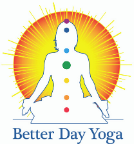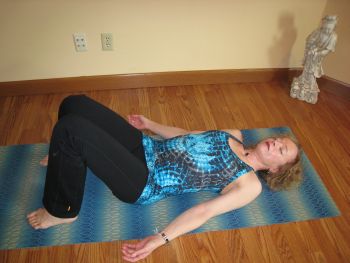
Since I opened with sharing my favorite magic portal as a child, I decided this was the perfect time to share my favorite magic portal as yoga teacher. Savasana is one of the most important poses in your yoga practice and it is often said that this is where the “magic” happens. This is the high point of your class where your body integrates all the work it’s done, integrating the healing benefits of your practice.
We so rarely take the time to be still, yet our nervous system requires stillness to heal and to run efficiently. I mentioned earlier that being open to receive is the first step to allow magic into your life. Final Relaxation / Savasana is the ultimate time to “be open” to the magic.
You experience a deep sense of release, contentment, rejuvenation, and—as the name implies—relaxation during Savasana. (Wish your final relaxations were a whole lot longer? You might like to try “Yoga Nidra” or “Yogic Sleep”. To experience an even deeper, more profound relaxation; check out my “Meditation On The Go” section below for more information.)
Yoga connects breath with movement, making it a moving meditation with the body. When you have completed your usual 60-75 minute Yoga class, and settle into final relaxation, your body is more ready for a total relaxation and more receptive to guided imagery and positive affirmations. Your body has been prepped to receive and is open to suggestion—open to the magic of healing. I typically offer a short meditation during final relaxation for this very reason, and end with a few minutes of total silence. Many of the meditations, affirmations, and guided imageries I use have been in my newsletters.
We don’t need to go into the research here documenting the power of the mind to heal the body, but suffice to say when we don’t use the power of our minds to improve the health and well-being of our bodies, we are negating the best partner on our health team—ourselves.
The August 2010 issue of Yoga Magazine had a great article on hypnosis http://www.yogamagazine.co.uk/. I remembered thinking at first, what does Yoga have to do with hypnosis? Then I remembered that Yoga is a somatic therapy using mind, body and breath. “Anything you do can be done better if you are relaxed. Sensory Awareness is the key to all Mind-Body methods. Mind-Body methods are practices that promote good health and enhance the quality of life.” The Mind-Body Connection, Linda-Christy Wiler, M.S. I can’t think of a better way to describe the benefits of Yoga.
“Hypnosis is a natural state of heightened awareness where you are using more of your mind than you usually do. The average person uses about 10% of his brain at any present moment. Hypnosis lets us relax and use 100% of our mind to create habits, positive affirmations and change behaviors with the help of the subconscious mind.” https://hyp-yoga.com/
I ran across the yoga/hypnosis connection again in an article from Yoga Journal magazine that highlighted Hyp-Yoga, the Web-site mentioned above, “Employing the use of visualization and commands, Hyp-Yoga helps students change their mental state, bringing about focus, clarity, and calm. It can be used for an entire sequence, but the benefits are greatest in Savasana (Final Relaxation).”
Ah! There’s that connection with final relaxation and the mind being prepped to do more when it’s in a state of relaxation! “Proponents of Hyp-Yoga believe it has the power to bring students into a trance-like state of heightened focus that is similar to states of consciousness during deep levels of meditation. This increased ability to concentrate is the result of elevated levels of gamma brain waves. Gamma brain waves are thought to be responsible for that ‘dropped in’ feeling advanced meditation brings about. According to a study by the Boston University School of Medicine, experienced yoga practitioners can help elevate gamma brain waves during a yoga session, and Hyp-Yoga techniques specifically trigger that state.”
Important note: Final relaxation pose should be at the end of both your hatha yoga practice and your pranayama/ breathwork practices. You should be in final relaxation at least five minutes for every hour of yoga practice. Never ever skimp on savasana!
Benefits:
- Teaches complete relaxation
- Relaxes the entire body, mind, and spirit
- Teaches you how to access relaxation easily in your daily life when needed
- Calms the brain
- Helps relieve stress and mild depression
- Reduces headache, fatigue, and insomnia
- Helps to lower blood pressure
- Returns cardiovascular circulation to normal
- The circulatory system is unobstructed and delivers oxygen, nutrients and white blood-cells to where it is needed. These materials are the building blocks of healing.
- Provides an important transition back into your daily routine
- Stimulates the crown chakra / enlightenment
- When you’re being held in a safe way, it supports you in letting go and coming back to feeling whole again. This is something you can learn to do for yourself and to share with others. (acupressure.com)
- Helps to bring all of your chakras into balance and harmony.
Alignment Cues: Prior to settling into the pose, it’s a good idea to cover yourself with a blanket and perhaps add some socks if you think you may get cold. Lie on your back, legs extended. Keep your neck and shoulders relaxed with the spine in one long, straight line. Turn your palms upward to the ceiling and allow the hands to move further away from the body than usual. Allow your feet to roll open. Let your breath relax and continue to release stress and tension in this pose, quieting the mind, relaxing completely, staying in the present moment. Let everything relax and let go.

For a deeper pose: I have never tried this, but it sounds luscious. It reminds me of the practice of using a weighted blanket to calm anxiety in people of all ages:
http://www.grandin.com/inc/squeeze.html
https://harkla.co/products/weighted-blanket and a recent resource given me on weighted blankets:
https://www.autismparentingmagazine.com/weighted-blankets-autism/
“To help release the brain and quiet the mind in Savasana, take a block and a 10-pound sand bag. After reclining on the floor, position the block on the floor above your head. The block should sit on one of its sides (the height of the block should be about 5 inches), with one of its ends lightly touching your crown. Then lay the sand bag half on the block and half on your forehead. Scrub the forehead skin down, toward your eyebrows. Then let the brain sink away from this weight.”
(Not Shown) (http://www.yogajournal.com/poses/482
Add a prop:
- For lower back injury or discomfort, with feet on the floor, knees can be bent and “steepled in”, leaning against one another, if you don’t have a prop to put under the knees.

- If you have a bolster, pillow, or towel to put under the knees, knees can be hip distance apart. (See next Photo below)
- You can also bind the thighs parallel to each other with a strap, being careful to keep the heels comfortably away from the buttocks.) (Not shown)
- Add an eye pillow for extra relaxation and inward focus. (See next Photo below)
- Add a rolled blanket if neck is strained or other prop under the head for comfort. Make sure your ears are centered in between the shoulders evenly.

- Add two ten pound bags on top of each thigh, parallel to the crease in the groin. This will allow the head of the thigh bones to relax toward the floor, creating more ease within the body. (Not shown)
Contraindicated for pregnancy: Raise your head and chest on a bolster or set of bolsters.

Variation: (Face Down / Relaxed Crocodile) This variation was introduced to me as a good option for those who might be experiencing Post-Traumatic Stress Syndrome. The vulnerability of an open chest may be too much for some.
This option would be offered as an “either / or” option. It’s not for everyone—especially if you are experiencing low back issues, and obviously if you are pregnant!
Start by lying face-down on your belly, and slightly spread the legs with toes turned out. With elbows bent, rest your forehead on the backs of your wrists.

You could also try having one cheek to the mat and changing to the other cheek around the half-way point. Then your hands would be either straight behind you, palms down; or one elbow bent and hand placed by the face on the side your cheek rests if your neck is tight. (Not Shown) (I often use the check side down version as a neutral pose after a back-bend series.)
Having your abdomen restricted by the floor, lets you play with breathwork using your chest, diaphragm and lower belly. You’ll more noticeably experience the rise and fall of your hips and lower back as your breath gently prompts the movement.
As the instructor, it can be nurturing to gently rock your student*. The rocking motion is very therapeutic. It’s not just for children! Rocking increases oxygen delivery to the cells and increases lymphatic circulation, increasing overall health, energy and alertness.
If students are laying belly-down on the floor, I always ask them to let me know if their neck is tight and they don’t want me to rock them.
Spiritual aspects of final relaxation pose: As outlined in the opening paragraphs of this section, this pose promotes the healing magic of the mind through the use of affirmations, creative visualization, and guided imagery. Savasana takes us to the still point in ourselves, where we can reconnect with the sacred by encountering the endless possibilities that emanate from your center.
“Relax into your wellness. Take good care of yourself and take all your hopes and dreams to heart. They carry the seeds of your destiny”. ~ Yoga path Cards by Susan Woldman
Sources: http://www.yogajournal.com/poses/482
Beth Shaw’s Yogafit®. The program for a more powerful, flexible, and defined physique, by Beth Shaw.



